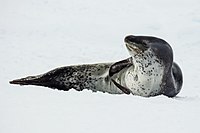
Photo from wikipedia
All organisms face resource limitations that will ultimately restrict population growth, but the controlling mechanisms vary across ecosystems, taxa, and reproductive strategies. Using four decades of data, we examine how… Click to show full abstract
All organisms face resource limitations that will ultimately restrict population growth, but the controlling mechanisms vary across ecosystems, taxa, and reproductive strategies. Using four decades of data, we examine how variation in the environment and population density affect reproductive outcomes in a capital-breeding carnivore, the northern elephant seal (Mirounga angustirostris). This species provides a unique opportunity to examine the relative importance of resource acquisition and density-dependence on breeding success. Capital breeders accrue resources over large temporal and spatial scales for use during an abbreviated reproductive period. This strategy may have evolved, in part, to confer resilience to short-term environmental variability. We observed density-dependent effects on weaning mass, and maternal age (experience) was more important than oceanographic conditions or maternal mass in determining offspring weaning mass. Together these findings show that the mechanisms controlling reproductive output are conserved across terrestrial and marine systems and vary with population dynamics, an important consideration when assessing the effect of extrinsic changes, such as climate change, on a population.
Journal Title: Proceedings of the Royal Society B: Biological Sciences
Year Published: 2021
Link to full text (if available)
Share on Social Media: Sign Up to like & get
recommendations!